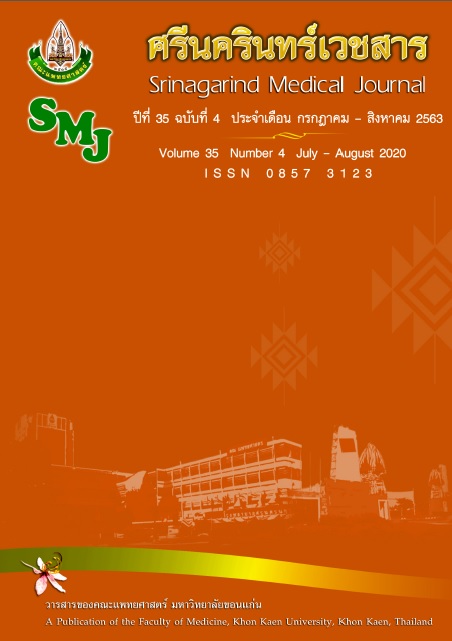Prevalence and Associated Factors of Poor Glycemic Control among Type 2 Diabetes Elderly Patients in a Community Hospital, Khon Kaen Province
Abstract
ความชุกและปัจจัยที่สัมพันธ์กับการไม่สามารถควบคุมระดับน้ำตาลในเลือดได้ตามเป้าหมายของผู้ป่วยเบาหวานสูงอายุในโรงพยาบาลชุมชนแห่งหนึ่ง จังหวัดขอนแก่น
พิทยาธร เวียงทอง, อาคม บุญเลิศ*
ภาควิชาเวชศาสตร์ชุมชน คณะแพทยศาสตร์ มหาวิทยาลัยขอนแก่น
หลักการและวัตถุประสงค์: โรคเบาหวานเป็นโรคเรื้อรังที่พบมากในผู้สูงอายุและมีผู้ป่วยจำนวนมากที่ไม่สามารถควบคุมระดับน้ำตาลในเลือดได้ตามเป้าหมาย ทั้งนี้ยังไม่พบการศึกษาอัตราความชุกและปัจจัยที่สัมพันธ์กับการไม่สามารถควบคุมระดับน้ำตาลในเลือดได้ตามเป้าหมายของผู้ป่วยเบาหวานสูงอายุในบริบทโรงพยาบาลชุมชน ดังนั้นผู้วิจัยจึงสนใจศึกษาหาความชุกและปัจจัยที่สัมพันธ์กับการไม่สามารถควบคุมระดับน้ำตาลในเลือดได้ตามเป้าหมายของผู้ป่วยเบาหวานสูงอายุในโรงพยาบาลอุบลรัตน์ จังหวัดขอนแก่น
วิธีการศึกษา: เป็นการศึกษาภาคตัดขวางเชิงพรรณนา (Cross-sectional descriptive study) คัดเลือกจากกลุ่มตัวอย่างผู้ป่วยเบาหวานที่อายุตั้งแต่ 65 ปีขึ้นไปที่มาติดตามการรักษาที่โรงพยาบาลอุบลรัตน์ จังหวัดขอนแก่น ในช่วงเดือนกันยายน – ธันวาคม พ.ศ. 2561 จำนวน 220 ราย เครื่องมือที่ใช้คือ 1) แบบบันทึกข้อมูลทั่วไป 2) แบบบันทึกข้อมูลสุขภาพ 3)แบบบันทึกข้อมูลการรักษาโรคเบาหวาน 4) แบบบันทึกข้อมูลความสามารถในการทำกิจวัตรประจำวัน L-IADL 5) แบบบันทึกข้อมูลสุขภาพครอบครัวและชุมชน 6) แบบบันทึกข้อมูลสุขภาพจิต 2Q และ 9Q และ 7) แบบบันทึกข้อมูลภาวะพุทธิปัญญาเสื่อมระยะแรก MoCA วิเคราะห์ข้อมูลโดยใช้สถิติเชิงพรรณนา ได้แก่ Frequency, Percentage, Prevalence rate with 95%CI, Mean (Standard deviation), Pearson Chi square, Odds ratio, Multiple Logistic Regression
ผลการศึกษา: กลุ่มตัวอย่างผู้ป่วยเบาหวานสูงอายุที่เข้าร่วมการศึกษาครั้งนี้มี 220 ราย คิดเป็นอัตราการตอบรับร้อยละ 100 เป็นหญิง 150 ราย (ร้อยละ 68.2) เป็นชาย 70 ราย (ร้อยละ 31.8) อายุเฉลี่ย 71.7±5.5 ปี (พิสัย 65-90 ปี) ความชุกของการไม่สามารถควบคุมระดับน้ำตาลในเลือดได้ตามเป้าหมายของผู้ป่วยโรคเบาหวานสูงอายุ (HbA1c >7.5%) พบร้อยละ 76.4 (95% CI 70.7-82.0) และปัจจัยที่สัมพันธ์กับการไม่สามารถควบคุมระดับน้ำตาลในเลือดได้ตามเป้าหมายของผู้ป่วยโรคเบาหวานสูงอายุอย่างมีนัยสำคัญทางสถิติ คือ ค่าระดับน้ำตาลในเลือดขณะอดอาหารที่สูงมากกว่า 170 มก./ดล. (adjusted OR = 8.1, 95% CI: 1.8-37.2)
สรุป: ความชุกของการไม่สามารถควบคุมระดับน้ำตาลในเลือดได้ตามเป้าหมายของผู้ป่วยโรคเบาหวานสูงอายุในโรงพยาบาลมีค่าค่อนข้างสูงและพบมากถึง 3 ใน 4 ของผู้ป่วยโรคเบาหวานสูงอายุและมีปัจจัยที่สัมพันธ์คือ ค่าระดับน้ำตาลในเลือดขณะอดอาหารที่สูงมากกว่า 170 มก./ดล.
คำสำคัญ: โรคเบาหวาน; ผู้สูงอายุ; โรงพยาบาลชุมชน
Background and objectives: Diabetes is a common chronic disease in the elderly. Most of them cannot reach a glycemic control goal. However, there were no previous studies about prevalence and associated factors of poor glycemic control among the type 2 diabetes elderly patients in Community hospitals. The purpose of this study was to find the prevalence and associated factors of poor glycemic control among type 2 diabetes elderly patients in Ubolratana hospital, Khon Kaen province.
Method: A cross-sectional descriptive study was conducted. The studied samples were selected from type 2 diabetes elderly patients (Age ³ 65) at Ubolratana hospital and interviewed during September in 2018 – December in 2018. 220 cases were included as studied samples. Instruments used were as follows: 1) questionnaire for demographic data, 2) questionnaire for Physical health and health behaviors, 3) questionnaire for diabetes treatment, 4) Lawton Instrumental Activities of Daily Living scale (L-IADL), 5) questionnaire for Family and social health, 6) 2-question (2Q) and 9-question (9Q) depression inventories and 7) Montreal Cognitive Assessment (MoCA) Thai version. Data analysis was conducted by frequency, percentage, prevalence rate with 95%CI, mean (standard deviation), Pearson Chi square, Odds ratio, and multiple logistic regression.
Results: The studied samples consisted of 220 subjects who registered in Ubolratana hospital. The response rate was 100%. There were 150 (68.2%) females and 70 (31.8%) males. Their mean age was 71.7±5.5 years (range: 65-90 years). The prevalence of poor glycemic control (HbA1c >7.5%) among type 2 diabetes elderly patients was 76.4% (95% CI: 70.7-82.0). The fasting blood glucose >170 mg/dL was a risk factor for poor glycemic control (adjusted OR = 8.1, 95% CI: 1.8-37.2).
Conclusion: There was a high prevalence of poor glycemic control among type 2 diabetes elderly patients in Community hospital setting. The study revealed that three-quarters of the type 2 diabetes elderly patient had poor glycemic control, and significantly related to fasting blood glucose >170 mg/dL.
Keywords: Type 2 diabetes; elderly patient; Community Hospital


